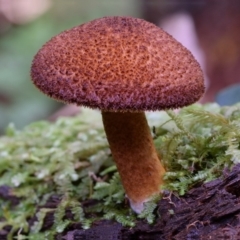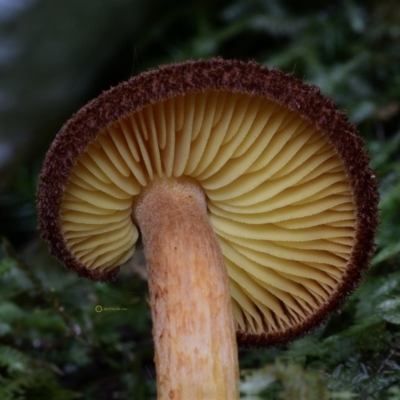Tricholomopis rutilans complex
A mature Tricholomopsis rutilans fruit body is a mushroom with a shallowly convex cap, perhaps with a shallow central hump, up to about 10 centimetres in diameter, atop a stem up to about 8 centimetres long and 1-3 centimetres wide. The base colour of the cap is yellow but the surface is covered with numerous reddish-purple fibrils, grouped into bundles so as to create a scaly effect. These scales are denser towards the centre of the cap. The gills are yellow and the stem is similar to the cap.
There is no partial veil.
Spore print: white.
Found on dead wood or on soil around the bases of live trees.
While this species has been reported from Australia there is some doubt as to whether all sightings are of this species. In the northern hemisphere Tricholomopsis rutilans is reported as associated with conifers but Australian examples of 'rutilans' have been found both near conifers and in conifer-free native woodlands or forests. In 2016 the rutilans-like species Tricholomopsis scabra was described from New Zealand. It occurs in tea-tree and podocarp forests. See Cooper & Park, The fungal genus Tricholomopsis (Agaricales) in New Zealand..., Phtyotaxa, 288 (1), pp 69-76.
Lookalikes
In Australia there is the odd species or two of Gymnopilus with purplish scales and yellowish gills. Two visual differences are that in Gymnopilus (1) the spore print is rusty brown and (2) there is a partial veil.
Tricholomopis rutilans complex is listed in the following regions:
Species information
- Tricholomopis rutilans complex Scientific name
- Common name
- Not Sensitive
- Cosmopolitan
- Non-invasive or negligible
- Machine learning
Location information
-
Maps
Bodalla State Forest





